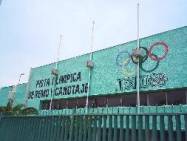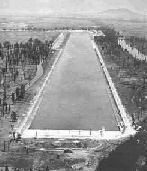|
Others |
|
|
OLYMPIC CUEMANCO
COURSE TopG
|
|
The Olympic Rowing and
Canoing Course, at Cuemanco, Xochimilco, was one of the new buildings for the
|
|
Thomas Keller, the FISA
president in that years, baptised the Cuemanco Course as the "Miracle
Course", because the express and very good construction. In 1966, when
the Course construction was annuncied, Keller said that he thought that it
was not possible. Nevertheless, the Course was finished in time and it was
the best Course in that years, and one of the best courses till the middle of
the 1980's. So, for the first time, the remo and canoing competitions taked
place in an artifitial course, avoiding the waves by natural flows. |
|
The Olympic Rowing and
Canoing Course was named "Virgilio Uribe", young member of the
|
|
The course is After the Mexico 68 Olympic
Games and till the middle of 1980's, the Marine Secretary was encharged for
the care of the Course. After that, the responsible was the Distrito Federal
Sport Department and, at the present, the Mexico City Governement throught
Xochimilco Delegation is responsible for the care of the Course. |
At the present days, in spite
of the Course bad conditions, there is an agreable variety of atlethes
practicing many sports like running, walking, basketball, weights, aerobics,
etc. in a total zone of 19 000m2 (
|
|
|
|
Xochimilco has its language
roots in the náhuatl mexican dialect. It is formed by xohitl,
that means flower; milli, cultivated field; and co, place.
"Flower fields place". The xochimilcas (people
that speaks clear) were one of
the 7 nahuatlaca tribes. By
919, they were the founder or the Xochimico old kingdom, at the south of mexican
valley. |
Their life depended of the
lake that supplied water for
In the rain epochs, the lakes
of the mexican valley, were cause of inundations. For that reason, the water
was protected with fences. Today, many water for the south of the city, comes
from Xochimilco.
Today, the Xochimilco
community controles the quantity of trees and calla lilies. Visitors can see
the chinampas taking a ride on the traditional trajineras, that
sail throught its canals.
The trajineras sailing
is a sample of the Xochimilco ancient tradition of "rowing". Today,
modern rowing and canoing are practiced in the canals and at the Cuemanco Olimpic
Course. People do not practice these sports at the old canals because the
motorized ships cause serious damages to the chinampas.
Rowing is one of the young's favorite sport. They often train at the
early morning in boats from many different clubs. Moreover, some years ago,
athletes from the "Xochimico Club" altough trained at the course.
|
|
Top
Main



